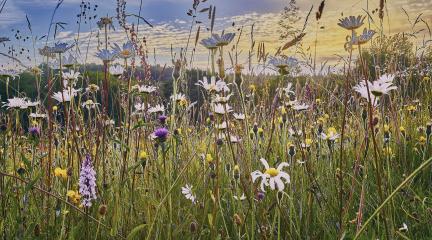
Cumbria has officially launched its Local Nature Recovery Strategy (LNRS), becoming the thirteenth LNRS to be published in England.
The strategy has been led by Westmorland and Furness Council, working in close partnership with Cumberland Council, the Lake District National Park Authority, the Yorkshire Dales National Park Authority, and Natural England.
Developed collaboratively, the Cumbria LNRS sets out clear priorities for restoring biodiversity across the county. It brings together existing environmental data, established local and national strategies, and, crucially, incorporates local knowledge and expertise to ensure that actions for nature recovery deliver the greatest possible positive impact for Cumbria’s distinctive landscapes and wildlife.
The LNRS will be formed of two parts: a Statement of Biodiversity Priorities and a Local Habitat and Opportunity Map. Together, these identify key priorities for nature recovery, outline potential measures to achieve them and highlight the geographical areas best suited for targeted interventions.
Its publication follows a public consultation earlier this year that invited residents, landowners, businesses, community groups, and anyone with an interest in nature recovery to share their views on a draft version of the document. Feedback from this consultation played a vital role in shaping the final version of the Cumbria LNRS.
Councillor Giles Archibald, Westmorland and Furness Council Cabinet Member for Climate, Biodiversity and Environmental Services, and LNRS Project Board Chair, said:
“Biodiversity loss remains one of the most urgent environmental challenges we face. Nature underpins so much of our daily lives - from the clean air we breathe and the water we drink, to the food we eat, the materials we build with and the green spaces that support our wellbeing. Yet across Cumbria, like elsewhere, many species and habitats are in decline.
“The Cumbria Local Nature Recovery Strategy sets out a clear, shared vision for reversing this trend. It is a guiding light for how we will restore and enhance nature across Westmorland and Furness. We know that we cannot achieve this alone. Nature restoration will only be possible through a huge collective effort across our communities, involving town and parish councils, landowners, voluntary organisations and local residents working together to create connected habitats and thriving ecosystems that benefit everyone.
“I want to thank everyone - individuals and organisations alike - who has played a part in bringing this vital document to life. Without your input, collaboration and commitment, it simply wouldn’t have been possible. But now the real work begins, turning this shared vision into tangible action on the ground that will make a lasting difference for nature, people and future generations.”
Cumberland Councillor Bob Kelly, Executive Member for Cumberland Environment and Planning, said:
“Two years of dedicated work have shaped this powerful strategy for nature recovery, and Cumberland Council is proud to be a key partner in this vital effort.
“The launch of this bold strategy brings together the public, private, and third sectors in a county-wide mission to make our shared landscapes richer in nature, for everyone to enjoy.”
Steve Ratcliffe, Assistant Chief Executive and Director of Sustainable Development, for the Lake District National Park Authority, said:
“We are delighted with the publication of the Cumbria LNRS, helping us deliver our ambitions to restore nature in the Lake District National Park. Working together with the Lake District National Park Partnership Management Plan and more specifically the Lake District National Park Partnership Nature Recovery Plan, we strongly support the Cumbria LNRS and look forward to making the strategy a success.”
Mark Corner, Member Champion for Natural Environment at the Yorkshire Dales National Park Authority, said:
“More than a quarter of the Yorkshire Dales National Park is covered by the Cumbria Local Nature Recovery Strategy. The strategy has identified key species in this area to conserve, such as red squirrel, swift and curlew. It will also direct conservation effort towards habitats such as limestone pavement in the Orton Fells including Asby Scar, blanket bog such as Tebay Fell, and the remnants of Atlantic rainforest as can be found in Dentdale and the Cautley valley. The Cumbria Local Nature Recovery Strategy will play a crucial part in nature recovery, so it’s great to be one of the partners involved in it.”
Lois Browne, Local Nature Recovery Strategy Senior Officer at Natural England, said:
“Natural England is delighted to support the launch of Cumbria's Local Nature Recovery Strategy, which is a major step in our collective efforts to reverse nature's decline across the county. By agreeing shared priorities and identifying key areas for habitat restoration and creation, we now have a clear, evidence-based framework to guide landscape-scale actions to support nature and communities.
“The collaborative approach taken in developing this strategy, bringing together local authorities, farmers, landowners, conservation groups and communities, demonstrates exactly the kind of partnership working needed to tackle the biodiversity and climate crises we face. We look forward to working with Westmorland and Furness Council and partners to turn this strategy into real action, creating bigger, better and more connected habitats where both wildlife and people can thrive.”
Cumbria is one of 48 designated LNRS areas in England, as established under the Environment Act 2021. Each area is responsible for developing its own locally tailored strategy for nature recovery.
Now finalised and submitted to the Department for Environment, Food and Rural Affairs (Defra), the Cumbria LNRS will act as a crucial guiding document for nature recovery work across the county. The strategy will be reviewed periodically - every three to ten years - to ensure it remains relevant and effective in responding to Cumbria’s evolving environmental needs.
For more information and to read the full strategy, visit the Cumbria LNRS website.
